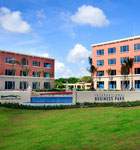In 2005, Jennifer Simpson and Keith Furones, founders of sustainable-design firm Simpson Furones International, were considering taking on projects outside of the United States. When the pair made their way to Panama for a potential project, they thought it was the best place for Americans to work outside of America. So, they transplanted their Boulder, Colorado, headquarters and, as Simpson puts it, put all their “eggs in the Panama basket.”
Coincidentally, the marketing director of a development called Panama Pacifico was also from Colorado and familiar with Simpson Furones’s track record for handling large commercial projects quickly and on budget. More importantly, the firm’s expertise in green building made it a rarity in Panama. Simpson Furones was thus entrusted with the task of designing the Panama Pacifico Visitor’s Center, which had to be both inviting and green. The project held its grand opening April 2010, and Simpson recently told gb&d what the project required.
Race the Clock
The visitor’s center was a small job compared to projects Simpson and Furones had handled in the past, but the true challenge was completing it in a short time frame—five months to be exact. Simpson and Furones had to redesign the space and lighting plans and make changes to the HVAC system. Shipping times for certain products also had to be factored in.
Panama is an international shipping hub rather than a manufacturing center, so many of the project’s materials had to be shipped in from the United States. Much had to be done in a short amount of time, including custom casework. Furones grew up in the construction industry and, according to Simpson, developed master carpentry skills at age 18. “To help the project stay on schedule, Keith stowed the business attire and strapped on a tool belt, building the reception desk, the arched ceiling detail, the base for the master model, and five residential model bases,” Simpson says.

Maintain Flexibility and Functionality
The visitor’s center had to be a lot of things to a lot of people. Panama Pacifico will ultimately have 20,000 residences and millions of square feet of commercial and industrial space, so Simpson and Furones had to be flexible in how the structure would function. “We wanted to create a world-class center that would appeal to multiple cultures and nationalities,” Simpson says. “Since the visitor’s center is where all aspects of the project are showcased to generate commercial and residential sales, our work needed to serve to complement rather than compete with the marketing displays.”
Educate the Area About Green
An unforeseen challenge of the Panama Pacifico job was educating those in the area about why green products and technologies are so important. Simpson says sustainability and life-cycle costing are new concepts to many there, but it didn’t stop her and Furones from trying to incorporate as many green features as possible, including solar window shades, recycled-content carpet, no-VOC carpet adhesives and paint, on-demand lighting controls, FSC woods, cork ceilings, and furniture from companies with environmentally friendly manufacturing practices.

“Reducing the thermal load was crucial in a tropical environment,” Simpson says. “Acoustics were vital so [that]multiple guided tours could take place concurrently. Good indoor air quality was important. And we wanted to have as many products as possible that would enhance the green story of Panama Pacifico. We basically did everything we could to provide a beautiful, functional, energy- and resource-efficient project as quickly as possible and within budget.”

